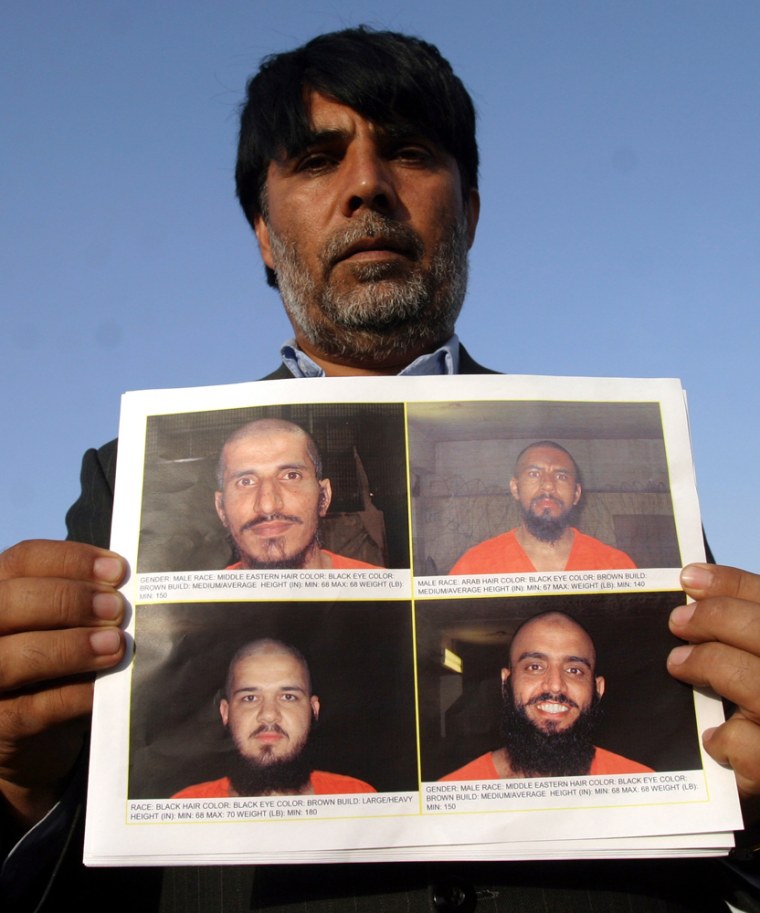Four suspected Arab terrorists broke out of a U.S. military detention facility in Afghanistan on Monday, fleeing through barbed wire stockades in the first escape from the compound since the American military took over the former Soviet airbase.
Also Monday, rescuers reported finding the body of a U.S. Navy SEAL, the last to be accounted for from a four-man special forces unit that disappeared after a June 28 ambush in the rugged mountains in the east of the country.
U.S. and Afghan forces launched a manhunt for the terror suspects, identified as Abdullah from Syria, Mohammed al-Qatari from Saudi Arabia, Mahmood Ahmad from Kuwait and Abulbakar Mohammed Hassan from Libya, according to local police chief Abdulrahman Mawalana. U .S. soldiers set up roadblocks and helicopters clattered low over villages near the heavily guarded base north of the capital, Kabul.
Bagram is in a wide, dusty plain at the foot of the Hindu Kush mountains, and much of the area around the base remains mined from Afghanistan's civil war and Soviet occupation. The base itself is surrounded by a series of barbed wire fences and is intensely guarded by U.S. troops. The main entrance is a series of checkpoints and all visitors are checked several times by U.S. military guards.
"They are considered dangerous and are suspected terrorists," U.S. military spokeswoman Lt. Cindy Moore told The Associated Press.
Local government chief Kaber Ahmad said, "coalition forces, police and Afghan troops have surrounded several villages near the base," and have distributed photos of the four, who have short hair and long beards.
Escapees described as ‘enemy combatants’
In the pictures, the men are wearing orange prison outfits and one man is grinning. Descriptions under the photos describe two of them as of Middle Eastern descent and the other as Arab. There is no description of the fourth.
Moore declined to identify the four escapees or elaborate on why they were being held. Another military spokesman, Lt. Col. Jerry O'Hara, described them only as "enemy combatants."
He said it was the first time anyone has broken out of Bagram's detention facility, where most of about 500 detainees in Afghanistan are held.
Suspected militants have broken out of other detention facilities. In 2003, 41 suspected Taliban rebels escaped from a government-run jail in the southern city of Kandahar by digging a tunnel.
Another setback for U.S. military
The escapes were another setback for the U.S. military as it struggles with insurgent fighting that has left more than 700 people dead in three months and threatened to sabotage three years of progress toward peace. Over the weekend, 22 Afghan soldiers were killed, including 10 who were beheaded.
The discovery of the body of the U.S. Navy SEAL in Kunar province on Sunday ended a desperate search for the final unaccounted for member of the special forces team. One of the four was rescued July 3, and two were found dead the next day.
The body was found by a search and rescue team, the military said. It said all indications are that he died in fighting, despite a claim by Mullah Latif Hakimi, a purported Taliban spokesman, that he was captured alive and beheaded.
“The location and disposition of the service member’s remains indicate he died while fighting off enemy terrorists on or about June 28,” the statement said.
U.S. military spokesman Col. James Yonts repeatedly denied Hakimi’s claims.
“There have been claims of being dropped on a mountain wearing red clothes, there have been claims of being beheaded,” he said. But “there was no indication supporting the claims. ... This individual was never in custody, he was never defamed or disgraced.”
He said the injuries on the commando’s body were consistent with “a firefight, a combat operation with small arms fire, RPG (rocket-propelled grenade) rounds.”
Hakimi never offered proof to back up his claim that the rebels were holding the commando, or that they had killed him. Information from Hakimi in the past has sometimes proven exaggerated or untrue, and his exact tie to the Taliban leadership cannot be independently verified.
Body found near crash site
The Navy SEAL team disappeared after a special forces helicopter carrying reinforcements to a mountainous area in eastern Kunar province was shot down June 28, killing all 16 Americans on board, the deadliest single attack on the U.S. military since the war here began in 2001.
Yonts said the commando’s body was found near the chopper crash site in an area “that we had looked over before, but where his body was located was hard to find.”
His name was not immediately released, pending notification of family.
The single surviving commando was saved from the militants by an Afghan shepherd, Gulab, who found him wounded in the mountains and took him to his home, according to this week’s Time magazine.
Despite demands from the rebels to hand over the American, Gulab and his neighbors refused to give him up because of a tribal honor code that bars them from refusing sanctuary to a guest, Time reported. The shepherd later escorted the American to the nearest U.S. base in the town of Asadabad.
U.S. military officials in Kabul have declined to comment on how the commando was rescued.
Kunar province has long been a hotbed of militant activity and a haven for fighters loyal to renegade former premier Gulbuddin Hekmatyar, who is wanted by the United States. U.S. officials said al-Qaida fighters also were in the region. Osama bin Laden was not said to be there — though he is believed to be somewhere along the Afghanistan-Pakistan frontier.
The region’s wooded mountains are popular with militants because they are easy to infiltrate from neighboring Pakistan and have plenty of places to hide.
